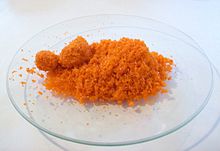Sodium dichromate

| |

| |
| Names | |
|---|---|
| IUPAC name
Sodium dichromate
| |
| Other names
Chromic acid, (H2Cr2O7), disodium salt
| |
| Identifiers | |
| ECHA InfoCard | 100.031.070 |
| EC Number |
|
PubChem CID
|
|
| RTECS number |
|
| UN number | 3288 |
CompTox Dashboard (EPA)
|
|
| Properties | |
| Na2Cr2O7 | |
| Molar mass | 261.97 g/mol (anhydrous) 298.00 g/mol (dihydrate) |
| Density | 2.52 g/cm3 |
| Melting point | 356.7 °C dehydrates at 100 °C |
| Boiling point | decomposes 400 °C |
| 730 g/L at 25 °C | |
| Hazards | |
| NFPA 704 (fire diamond) | |
| Lethal dose or concentration (LD, LC): | |
LD50 (median dose)
|
50 mg/kg |
| Related compounds | |
Other anions
|
Sodium chromate Sodium molybdate Sodium tungstate |
Other cations
|
Potassium dichromate Ammonium dichromate |
Except where otherwise noted, data are given for materials in their standard state (at 25 °C [77 °F], 100 kPa).
| |
Sodium dichromate is the chemical compound with the formula Na2Cr2O7. Usually, however, the salt is handled as its dihydrate Na2Cr2O7·2H2O. Virtually all chromium ore is processed via conversion to sodium dichromate. In this way, many millions of kilograms of sodium dichromate are produced annually.[1] In terms of reactivity and appearance, sodium dichromate and potassium dichromate are very similar. The sodium salt is, however, around twenty times more soluble in water than the potassium salt (49 g/L at 0 °C) and its equivalent weight is also lower, which is often desirable.[2]
Production
Sodium dichromate is generated on a large scale from ores containing chromium(III) oxides. The ore is fused with a base, typically sodium carbonate, at around 1000 °C in the presence of air (source of oxygen):
- 2 Cr2O3 + 4 Na2CO3 + 3 O2 → 4 Na2CrO4 + 4 CO2
This step solubilizes the chromium and allows it to be extracted into hot water. At this stage, other components of the ore such as aluminium and iron compounds, are poorly soluble. Acidification of the resulting aqueous extract with sulfuric acid or carbon dioxide affords the dichromate, which is isolated at the dihydrate by crystallization. Since chromium(VI) is toxic, especially as the dust, such factories are subject to stringent regulations. For example, effluent from such refineries is treated with reducing agents to return any chromium(VI) to chromium(III), which is less threatening to the environment.[1] A variety of hydrates of this salt are known, ranging from the decahydrate below 19.5 °C (CAS# 13517-17-4) as well as hexa-, tetra-, and dihydrates. Above 62 °C, these salts lose water spontaneously to give the anhydrous material.
Reactions
Dichromate and chromate salts are oxidizing agents. For the tanning of leather, sodium dichromate is first reduced with sulfur dioxide.
In the area of organic synthesis,[2] this compound oxidizes benzylic and allylic C-H bonds to carbonyl derivatives. For example, 2,4,6-trinitrotoluene is oxidized to the corresponding carboxylic acid.[3]. Similarly, 2,3-dimethylnaphthalene is oxidized by Na2Cr2O7 to 2,3-naphthalenedicarboxylic acid.[4]
Secondary alcohols are oxidized to the corresponding ketone, e.g. menthol to menthone;[5] dihydrocholesterol to cholestanone:[6]
- 3 R2CHOH + Cr2O72- + 2 H+ → 3 R2C=O + Cr2O3 + 4 H2O
Relative to the potassium salt, the main advantage of sodium dichromate is its greater solubility in water and polar solvents like acetic acid.
Safety
Like all hexavalent chromium compounds, sodium dichromate is considered hazardous. It is also a known carcinogen[7].
References
- ^ a b Gerd Anger, Jost Halstenberg, Klaus Hochgeschwender, Christoph Scherhag, Ulrich Korallus, Herbert Knopf, Peter Schmidt, Manfred Ohlinger, "Chromium Compounds" in Ullmann's Encyclopedia of Industrial Chemistry, Wiley-VCH, Weinheim, 2005.
- ^ a b Freeman, F. "Sodium Dichromate" in Encyclopedia of Reagents for Organic Synthesis (Ed: L. Paquette) 2004, J. Wiley & Sons, New York. DOI: 10.1002/047084289.
- ^ Clarke, H. T.; Hartman, W. W. (1941). "2,4,6-Trinitrobenzoic Acid". Organic Syntheses
{{cite journal}}: CS1 maint: multiple names: authors list (link); Collected Volumes, vol. 1, p. 543. - ^ Friedman, L. (1973). "2,3-Naphthalenedicarboxylic Acid". Organic Syntheses; Collected Volumes, vol. 5, p. 810.
- ^ L. T. Sandborn (1929). "l-Menthone". Organic Syntheses. 9: 59; Collected Volumes, vol. 1, p. 340.
- ^ W. F. Bruce (1941). "Cholestanone". Organic Syntheses; Collected Volumes, vol. 2, p. 139.
- ^ ILO 1369 - Sodium Dichromate [1]

